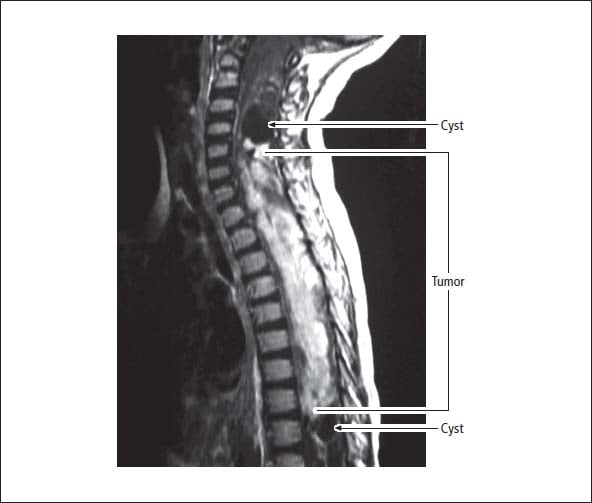Childhood Brain and Spinal Cord Tumors
Spinal cord
At the base of the brain (in the back), the brain becomes the spinal cord—a long, tough bundle of nerve fibers that runs down the back and is protected from harm by the vertebrae of the spine. The spinal cord is the pathway for nerve impulses that travel to and from the brain to all parts of the body. Tumors can grow inside or outside the spinal cord or, in some cases, twine around the cord. Symptoms of tumors in the spinal cord include:
- Back or leg pain that awakens the child from sleep
- Curvature of the spine
- Weakness in arms or legs
- Changes in sensation (tingling, numbness) in the back, arms, or legs
- Changes in bowel and bladder function
Danny (age 8) began having infrequent bouts of headaches and vomiting at odd times, not always in the morning. He also told me that he was having strange half-second blackouts. After a couple visits to the pediatrician, we found he had swelling of the optic discs, papilledema. Other than that, he passed all neurological tests. Finally, a CT scan showed hydrocephalus. Just before a shunt was placed, an MRI of the head showed multiple lesions all over the brain. Our doctors recommended a spinal MRI to check if the brain lesions were spread from the spine. The MRI of the spine showed the same pattern of unusual lesions. It was like a sugar coating all along the meningeal lining of the spine without any hard central mass.
Figure 2–5 shows an MRI scan of a tumor causing the spine to curve.

Figure 2–5: A spinal cord tumor
Table of Contents
All Guides- Introduction
- 1. Diagnosis
- 2. The Brain and Spinal Cord
- 3. Types of Tumors
- 4. Telling Your Child and Others
- 5. Choosing a Treatment
- 6. Coping with Procedures
- 7. Forming a Partnership with the Treatment Team
- 8. Hospitalization
- 9. Venous Catheters
- 10. Surgery
- 11. Chemotherapy
- 12. Common Side Effects of Chemotherapy
- 13. Radiation Therapy
- 14. Peripheral Blood Stem Cell Transplantation
- 15. Siblings
- 16. Family and Friends
- 17. Communication and Behavior
- 18. School
- 19. Sources of Support
- 20. Nutrition
- 21. Medical and Financial Record-keeping
- 22. End of Treatment and Beyond
- 23. Recurrence
- 24. Death and Bereavement
- 25. Looking Forward
- Appendix A. Blood Tests and What They Mean
- Appendix C. Books and Websites

